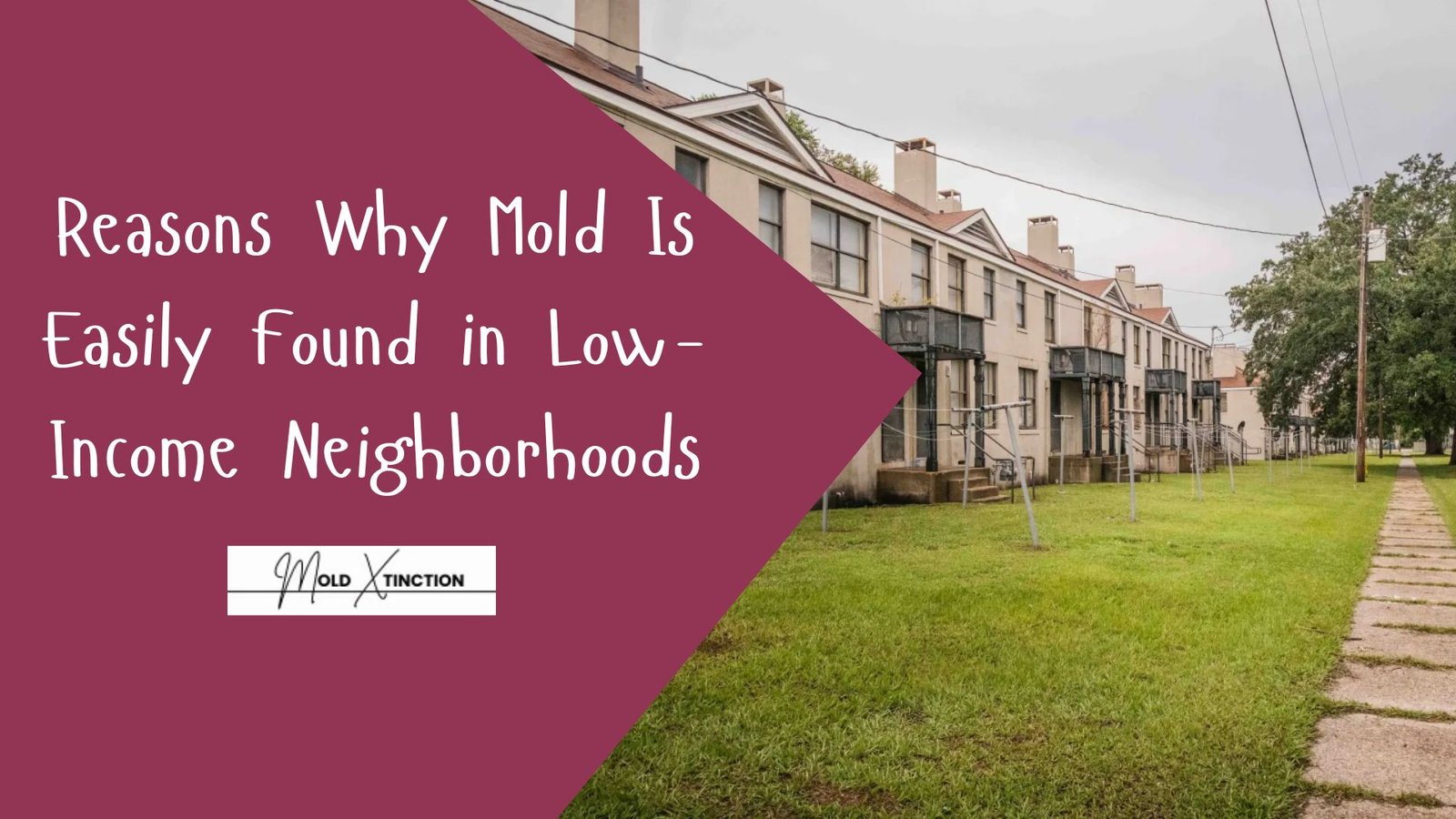You might be wondering about the reasons why mold is easily found in low-income neighborhoods, isn’t it?
We all understand that low-income neighborhoods are those areas where the majority of the people earn less as compared to those in other cities or towns.
In these regions, it is difficult to afford items such as proper housing, food, and medical services, among other things by families.
The houses there could be worn out or require repairs due to a lack of money for the people to repair them.
We also experience a decline in available public services such as parks and good schools.
Due to these disabilities, problems such as mold and other health hazards occur more frequently in low-income neighborhoods.
Mold is an issue that most of the population will come across in their houses. It appears to be black, green, or white, which appears on the walls, ceiling, or floor.
The mold may lead to poor odors, house destruction, and even health-related conditions such as cough and allergies.
But have you ever thought as to why there is higher mold prevalence in poor neighborhoods? Why does mold appear to be more problematic to people with less money?
Not only will this article inform you about what the causes of the growth of the molds in such neighborhoods are but also what you can do to handle the situation.
What's In This Article
ToggleReasons Why Mold Is Easily Found in Low-Income Neighborhoods

Okay, so we are going to think about why mold is more prevalent in low-income neighborhoods.
1. Old Buildings And Poorly Maintained Buildings
Most of the dwellings in low-income areas are ageing. They are buildings with poor walls, broken pipes, or worn-out roofs.
These issues result in leakages over time. The floors and the walls become wet as water enters them. This moisture makes mould to grow perfectly.
Homes in richer areas can be younger or at least well-maintained. Small issues occur, which are quickly resolved when they arise.
People who live in low-income neighborhoods may not be able to eradicate it because they don’t have the finances to carry it out, due to the high cost of professional repair. This provides an opportunity for growth to mold.
2. Absence of Good Air Conditioning and Warm Heating (HVAC)
When a house or building has the right warmth or heat it requires and there is a good airflow system, mould hardly survives.
And you know mould without damp is like chickens without feathers. Houses with proper heating and cooling system are hardly available in such an environment.
When the house lacks proper ventilation, moisture trapped in the house causes rotting.
Rooms such as bathrooms, kitchen and basements will be wet and become mouldy. This humid air contributes to the growth as well as the spread of mould.
3. Weather and high-humidity Conditions
There is a higher level of weather influences in buildings in low-income neighborhoods. Houses that are not well waterproofed become wet very easily when there is a lot of rain or there is high humidity.
Absence of good barriers makes water find its way into the house through holes or leakage. This forms a humid setting, and mold grows in it.
4. Crowded Housing Conditions
A large number of people occupy small places in most low-income residential areas. Due to a high level of breathing, cooking, and washing activities, overcrowding may lead to an increased level of humidity in a house.
Having a large number of individuals in a single home, it more difficult to maintain the air warm and dry. This contributes to the growth of moldings since there is built-up moisture.
5. Resources to Prevent Mold are Sparse
Residents of low-income neighborhoods might lack the finances or resources to stop or eliminate mould.
They may not be able to afford other cleaning items, repair leaks or install ventilation systems.
In the absence of these, mold issues develop with time.
6. Unawareness About the Dangers of Mold
And sometimes, they are not aware of how destructive mould can be and how to prevent it.
In regions with low income, it is possible that the information on mould and health risks are not readily available.
Without knowing that mold is harmful to well-being, individuals may take time before cleaning or repairing the situation. This makes mold spread and causes further destruction.
The Effects of Molds on People Living in Low-Income Neighborhoods
Mold not only destroys homes. It may lead to severe health effects.
Mold Health Risk
- Allergies: Mold is known to trigger sneezing, runny nose and itchy eyes.
- Asthma: Mold can cause an asthma attack and increase difficulty in breathing.
- Respiratory Problems: Breathing of the mold may also lead to coughing, wheezing and sore throat.
- Infections: Individuals whose immunity is acting low can become victims of infections with mold.
The most vulnerable people are children, elderly and those with asthma or allergies. Mold-related conditions might not be treated since most of the low income households lack access to healthcare.
Economic Impact of Mold
Mold is capable of ruining houses when it is not addressed on time. It is able to destroy walls, floors and furniture by making them weak and damaged. It is also possible that the presence of Mold will lead to unpleasant odors that you will not want to stay in such house.
The costs of repairing the damage caused by the molds is usually high as there are may be cases where the entire walls or floors have to be changed.
To a low-income earning family, this cost of repairs may be extremely difficult. In most occasions, they lack sufficient finances to rectify the mold issue effectively. Due to this reason, there are individuals who have to co-exist with molds in their residential buildings.
Sadly, their health may worsen because they live with mold that causes them to have breathing difficulties, allergies and other diseases, more to the children and older adults.
What Can Be Done to Reduce Mold in Low-Income Neighborhoods?
There is a need to assist in minimizing the issue of molds in such neighborhoods. These are simple and useful steps:
1. Repair Leaks promptly
When you suspect any leakage water through pipes, roof or walls, it is highly crucial to ensure that you fix the leakage immediately.
Small leaks might not matter, but they can lead to large problems in forms of mold as time passes. Standing water in the walls or the floors provides an ideal location of mold growth.
Therefore, the quicker you repair leaks, the more it will be beneficial to the house and to the health of people.
2. Improve Ventilation
Good ventilation will dry up your home and give it good fresh air. When possible, put open windows to allow the fresh air to get in and the wet air to get out.
Have fans in rooms such as kitchen and bathroom where there is so much wetness that comes with both cooking and washing. This assists in eliminating additional humidity and prevents the growth of mold.
3. Use Dehumidifiers
Where the air is very wet or humid, a dehumidifier may remedy the situation. The machine takes moisture out of the air and dries your house out making it less hospitable to molds.
4. Properly Clean Mold
When you notice molds growing, you must not ignore them. Wash the surface of the mold with soaps and water or use mold specific cleaners. Once you have cleaned up, ensure that it is dry so that molds will not recur.
5. Educate communities on Mold
Mold is bad and, therefore, everyone should understand the times when it is a problem and how to prevent them.
Families can be educated by means of community programs about the dangers of mold and ways of preventing it in the house.
6. Government and Organization Support
It is also difficult in some cases to achieve mold solutions inside the family due to financial strength or due to poverty.
You can assist in the government programs and local bodies since they can repair the homes, distribute supplies which can include teaching people about ways to prevent molds so that the community remains healthy.
Why It Is Better to Call a Professional Remediation Service
There are cases in which the mold issues have become so large or hard to solve on their own.
Mold remediation is not a problem because professional services have the necessary tools, knowledge and experience to handle mold in a secure and complete manner.
They can:
- Discover lurking mold sneaking behind walls, ceilings, and under floorboards where you would not even detect any.
- Eradicate mold safely, keeping spores out of other parts of your house.
- Stop the causes of mold like leaks, poor ventilation or dampness so that it does not recur.
- Sterilize and dry the house so as to render it safe and healthy.
Any attempt to eliminate mold without appropriate training and tools can aggravate an issue and eventually hurt your health.
When you reside in a home with mold, particularly in low-income communities where mold grows is more evident, then calling a mold remediationienst should be your most suitable and secure alternative.
They will assist in the security of your home as well as the health of your family members.
Conclusion
Mold problems are common in low-income neighborhoods due to numerous challenges that surround them. Leaks and dampness occur very easily because homes in such places are usually old and not well-maintained.
A lot of houses had poor heating or ventilation, and as a result, moisture accumulates indoors. Humidity increases as there are too many people living in small areas, and this facilitates the growth.
And because of this, the families living in such communities might lack the finances to rectify issues or purchase cleaning materials. In some instances, they are not even aware of the harmful effects of molds.
All these combined provide the optimum environment in which molds can grow.
This is why we need to treat mold seriously and need to call specialists in mold removal to make our homes healthy and safe.
Helpful Guide: How to Identify Building Materials That Attract Mold


